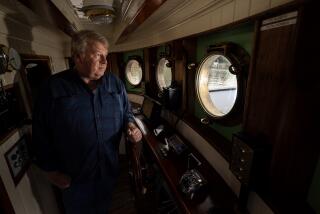A Cooked Goose? : Plane’s Fate Hangs in Balance of Disney Decision on Project
- Share via
Howard Hughes’ fantastic flying machine, the Spruce Goose, seemingly has spent its entire star-crossed career trying to recapture its one golden moment in the sun. The question now is whether the massive seaplane, its wings clipped long ago, can survive at all.
Preliminary plans unveiled last week by the Walt Disney Co. for a $2-billion resort and theme park in Long Beach exclude the historic flying boat now housed on the 300-acre proposed site. But the outcome remains uncertain because Disney is undecided about the site and is still considering an alternative site in Anaheim, near Disneyland.
Nevertheless, speculation about what will become of the historic flying boat, which has been surrounded by almost as much mystery as the reclusive Hughes himself, ranges from the mundane to the fantastic.
There is talk of dismembering the giant wooden bird for a trip across the desert and reassembling it amid the glitz of Hughes’ onetime hometown of Las Vegas. Other entrepreneurs envision it as a spectacular centerpiece of a large real estate development.
Some fans who want to see it kept in one piece--and who say that moving it out of Southern California would be like moving Hollywood to the Midwest--favor transporting the entire plane aboard a giant ocean barge, perhaps powered by its own propeller engines, to another port city in the region.
Finally, there are those who, letting their imaginations take flight, speculate about what may appear as the simplest solution of all--letting the old bird fly out of Long Beach on its own power.
It would be only its second flight since Hughes piloted the huge airplane on its one-minute maiden voyage in 1947, before secreting it away to a hangar. With the end of World War II, the giant cargo plane, designed to transport tanks and troops, already was destined to be a relic of the pre-jet-propulsion age. When Hughes apparently finally admitted that time had passed by the grand old flying boat, he had it put away. But he ordered the plane maintained in flying order until a few years before his death in 1976.
Having lost its most loyal patron, the Spruce Goose fell on hard times. Evicted from its home by the Port of Long Beach, which needed the land to construct an oil tanker terminal, the homeless Goose was to be cut into pieces and scattered across the country for display at various aviation museums. The seaplane was saved when the management firm that took over the legendary Queen Mary for exhibition in Long Beach offered to incorporate the Spruce Goose into the nostalgic display.
More than 5 million people have visited the Spruce Goose and, no doubt, felt dwarfed at the sight of the spectacular aircraft’s Gargantuan dimensions. The craft’s wingspan is longer than a football field; its tailspan, the height of an eight-story building.
Inside its aluminum dome, the flying boat appears in flight-ready condition and rests in the middle of a reflecting pool with its huge wings tied down to the floor with heavy metal cables, giving the impression that it might otherwise take flight.
The Goose’s most avid fans want the plane kept there.
“It’s a magnificent thing and it’s horrible that the possibility exists that we will lose it,” said Donald E. Madonna, director of the Museum of Flying in Santa Monica.
“I think it should stay in Southern California. That’s where Howard Hughes built it and that’s where it belongs,” he said.
Others noted that its present location lies on the very path of its brief flight five decades ago.
Merle Coffee, the radio operator on that day 43 years ago when Hughes unexpectedly lifted the Goose off the water after a series of scheduled taxi test runs, had looked forward to seeing the Goose take to the skies again.
But Coffee, like scores of others who worked for years carefully crafting the giant, could not know the Goose’s brief minute aloft would be its last.
It was heartbreaking, said Coffee, now 70, to see the flying boat put away in a hangar for 30 years. “It was a waste of manpower,” he said. A “masterpiece” that would go unappreciated.
The next time he saw the Spruce Goose, it was from the stern of the Queen Mary. The Goose was finally out in the world--where it belonged, Coffee said. “It was exactly the way we wanted it to be preserved, in such a way as to allow people the opportunity to go see it.”
Among those who had led the effort to save the Goose in the late 1970s was Bill Berry, the former director of the entire Spruce Goose project. Proposals back then included moving it to the Salton Sea, the San Francisco Bay Area and Las Vegas. Even actor John Travolta, an aviation buff, had expressed interest in buying it, Berry said.
Berry and others opposed a plan to break the plane into pieces to move it, which would have ruined its structural integrity. Although they determined that flying the Goose would be impractical, Berry said it would not be impossible.
“You can’t say these things are impossible,” he said, adding that the very existence of the Spruce Goose is proof of that.
Berry and Coffee said they would hate to see the Spruce Goose torn apart to be moved and reassembled elsewhere. They said that because of its unique construction, the ship could never be put back together in the same way.
Others, like Nissen Davis, president of the Aero Exhibits Corp., which owns the Spruce Goose on behalf of the Aero Club, believe that such “purist” attitudes are a luxury the campaign to save the Goose can ill afford.
(In 1981, the government turned the plane over to the nonprofit Aero Club corporation to facilitate leasing it to Wrather Corp. Wrather is the management company that operated the Queen Mary and the Spruce Goose until it sold both leases to the Disney Co.)
Although “not anxious” for a move that would require the Spruce Goose to be dismantled, Davis added that he is a “realist” and would not reject out of hand any potentially viable proposals--such as one from a group of investors that has expressed interest in moving the craft to Las Vegas as the centerpiece for an aviation-related convention center.
Some aviation enthusiasts and even some former Spruce Goose crew members say it is too early to start earnestly planning the airplane’s next nest.
Disney unveiled its master plan for the 350-acre entertainment complex just last week and, it is generally agreed, the long and tortuous approval process for the project could take from two to five years. The project could also fall apart at any stage if the various entities involved--including the city, the California Coastal Commission and Disney--fail to come to terms. Even if approved, completion of the theme park could take as long as 10 years.
Some people are pessimistic about the Spruce Goose finding a home at all because of the great expense and enormously difficult logistics of moving the oversized plane. Thus, some argue that it is not too early to begin a new effort to ensure preservation of the aviation relic.
“All kinds of people are speculating and coming up with different possibilities. It gets a lot of people’s juices flowing,” said Davis, of the Aero Club. “But it’s one thing to express interest and another to come up with the money it would take.”
Davis noted that it cost more than $2 million to move the Goose the short distance to its present location with the aid of a giant floating crane.
More to Read
Sign up for Essential California
The most important California stories and recommendations in your inbox every morning.
You may occasionally receive promotional content from the Los Angeles Times.










